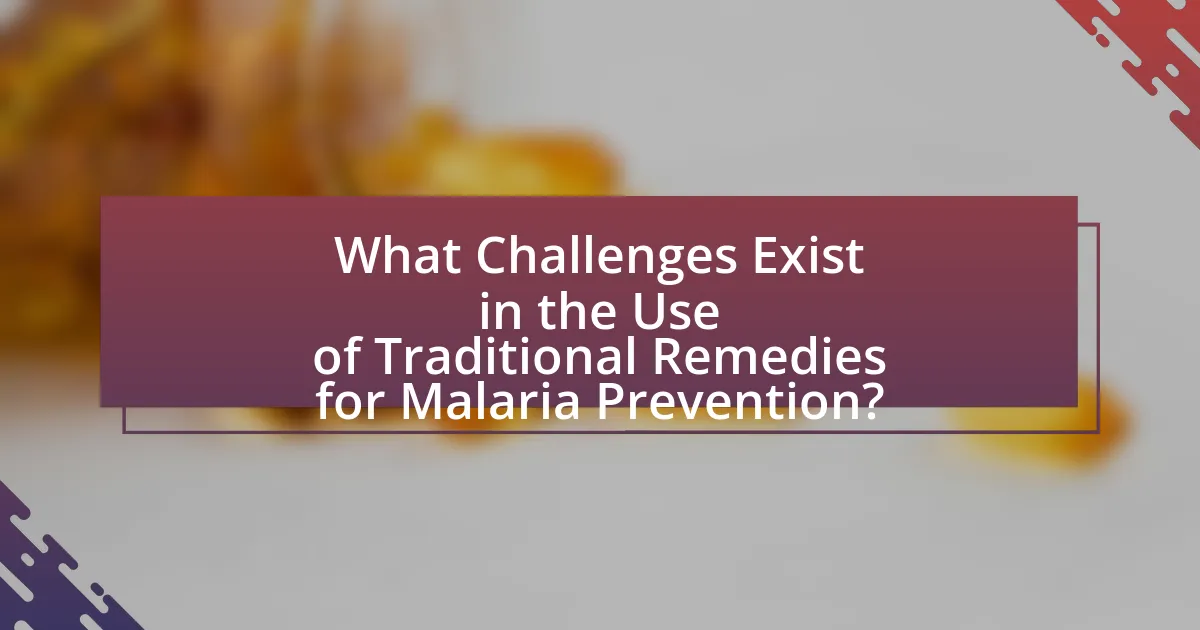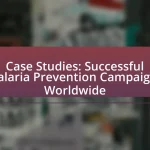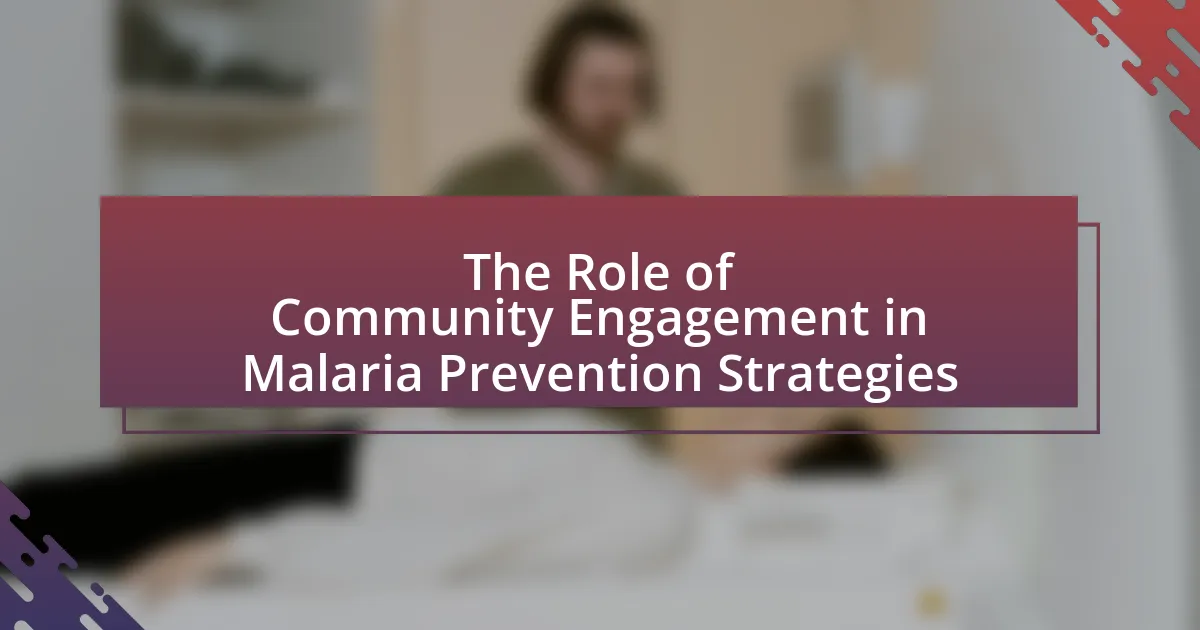The article explores traditional remedies and their role in modern malaria prevention, focusing on the use of herbal plants and natural substances believed to repel mosquitoes or enhance immunity. It highlights the historical significance of remedies like Artemisia annua and Cinchona bark, which have been utilized for centuries in various cultures. The article discusses the effectiveness of these remedies, the influence of cultural beliefs on their use, and the potential for integrating traditional practices with modern medical approaches. Additionally, it addresses the challenges and limitations of relying solely on traditional remedies, emphasizing the importance of scientific validation and collaboration between traditional healers and healthcare professionals in malaria prevention efforts.

What are Traditional Remedies in the Context of Malaria Prevention?
Traditional remedies in the context of malaria prevention include the use of herbal plants and natural substances believed to repel mosquitoes or enhance immunity. For instance, plants like Artemisia annua, known for its antimalarial properties, have been utilized in various cultures for centuries. Additionally, essential oils from citronella and eucalyptus are commonly applied topically to deter mosquito bites. These remedies are often rooted in indigenous knowledge and have been supported by some studies indicating their effectiveness in reducing malaria transmission rates in specific regions.
How have traditional remedies been used historically to combat malaria?
Traditional remedies have historically been used to combat malaria through the utilization of various plant-based treatments. Indigenous cultures in regions affected by malaria, such as Africa and South America, have relied on plants like Artemisia annua, which contains artemisinin, a compound effective against malaria parasites. Historical records indicate that traditional healers employed these remedies long before the advent of modern pharmaceuticals, with documented use dating back to ancient Chinese texts from the 4th century AD. Additionally, the World Health Organization recognizes the significance of traditional medicine in malaria treatment, highlighting its role in local healthcare systems and its integration with modern approaches.
What specific plants and substances are commonly used in traditional malaria remedies?
Specific plants and substances commonly used in traditional malaria remedies include Artemisia annua (sweet wormwood), Cinchona bark, and neem leaves. Artemisia annua is the source of artemisinin, a key compound in modern antimalarial drugs, demonstrating its historical significance in malaria treatment. Cinchona bark contains quinine, which has been used for centuries to treat malaria, and neem leaves are known for their antimalarial properties in various traditional medicine systems. These plants have been validated through historical usage and scientific studies, confirming their roles in combating malaria.
How do cultural beliefs influence the use of traditional remedies for malaria?
Cultural beliefs significantly influence the use of traditional remedies for malaria by shaping perceptions of illness and treatment. In many communities, traditional remedies are viewed as effective due to historical practices and cultural narratives that endorse their use. For instance, in regions where malaria is endemic, local populations often rely on herbal treatments passed down through generations, believing these remedies are more aligned with their cultural identity and spiritual practices. Research indicates that approximately 70% of people in sub-Saharan Africa utilize traditional medicine for malaria, reflecting a deep-rooted trust in these practices over modern pharmaceuticals. This reliance is often reinforced by community leaders and healers who advocate for traditional methods, further embedding these beliefs within the cultural framework.
What is the significance of traditional remedies in modern malaria prevention?
Traditional remedies play a significant role in modern malaria prevention by providing alternative and complementary approaches to conventional treatments. These remedies, often derived from local plants and traditional knowledge, can enhance the effectiveness of existing malaria prevention strategies. For instance, the use of artemisinin, extracted from the sweet wormwood plant, has been pivotal in developing effective antimalarial drugs, demonstrating the potential of traditional knowledge in modern medicine. Additionally, traditional practices may improve community engagement and acceptance of malaria prevention measures, as they resonate with local cultural beliefs and practices.
How do traditional remedies complement modern medical approaches to malaria?
Traditional remedies complement modern medical approaches to malaria by providing additional therapeutic options and enhancing patient care. For instance, herbal treatments such as Artemisia annua, which is used in traditional Chinese medicine, have been shown to contain artemisinin, a key compound in modern antimalarial drugs. This synergy allows for a more holistic approach to treatment, potentially improving efficacy and reducing drug resistance. Furthermore, traditional practices often emphasize preventive measures, such as the use of mosquito-repellent plants, which can work alongside modern interventions like insecticide-treated nets. Studies indicate that integrating traditional knowledge with contemporary medical practices can lead to better health outcomes in malaria-endemic regions, as evidenced by community-based programs in Africa that successfully combine both approaches.
What role do traditional healers play in malaria prevention today?
Traditional healers play a significant role in malaria prevention today by providing culturally accepted remedies and health education within their communities. They often utilize local plants with antimalarial properties, such as Artemisia annua, which has been shown to have efficacy against malaria parasites. Additionally, traditional healers serve as trusted figures who can disseminate information about malaria prevention methods, including the importance of using insecticide-treated bed nets and seeking prompt treatment for symptoms. Their integration into formal health systems can enhance community engagement and improve overall malaria control efforts, as evidenced by studies indicating that collaboration between traditional and modern healthcare providers can lead to better health outcomes in malaria-endemic regions.

How Effective are Traditional Remedies Against Malaria?
Traditional remedies against malaria have shown varying degrees of effectiveness, with some demonstrating potential benefits while others lack scientific validation. For instance, artemisinin, derived from the sweet wormwood plant, is a traditional remedy that has been proven effective in treating malaria and is now a key component of modern antimalarial therapies. However, many other traditional remedies, such as certain herbal concoctions, have not undergone rigorous clinical testing, leading to uncertainty regarding their efficacy. Research indicates that while some traditional practices may provide symptomatic relief or support overall health, they should not replace proven antimalarial treatments.
What scientific evidence supports the efficacy of traditional remedies in malaria treatment?
Scientific evidence supporting the efficacy of traditional remedies in malaria treatment includes studies demonstrating the antimalarial properties of specific plants. For instance, artemisinin, derived from the sweet wormwood plant (Artemisia annua), has been validated through clinical trials as an effective treatment for malaria, significantly reducing parasite levels in patients. Research published in the journal “Nature” by Tu Youyou, who discovered artemisinin, highlights its effectiveness against Plasmodium falciparum, the most deadly malaria parasite. Additionally, a systematic review in “BMC Complementary Medicine and Therapies” found that various traditional herbal remedies, such as neem and garlic, exhibit antimalarial activity, further supporting their potential role in malaria treatment.
Which studies have been conducted to evaluate the effectiveness of these remedies?
Several studies have been conducted to evaluate the effectiveness of traditional remedies in malaria prevention. For instance, a systematic review published in the journal “Malaria Journal” in 2018 analyzed various herbal remedies used in different cultures and found that certain plants, such as Artemisia annua, demonstrated significant antimalarial properties. Another study by the World Health Organization in 2020 assessed the efficacy of traditional medicine practices in rural African communities, highlighting the use of local plants and their integration with modern treatments. Additionally, research conducted by the University of Ghana in 2019 focused on the pharmacological effects of specific herbal mixtures, confirming their potential in malaria management. These studies collectively provide evidence supporting the role of traditional remedies in combating malaria.
What are the limitations of relying solely on traditional remedies for malaria prevention?
Relying solely on traditional remedies for malaria prevention has significant limitations, primarily due to their lack of scientific validation and efficacy. Traditional remedies often lack standardized dosages and may not address the complexities of malaria transmission, which is primarily caused by the Anopheles mosquito. Furthermore, many traditional remedies have not undergone rigorous clinical trials to establish their effectiveness or safety, leading to potential health risks. For instance, the World Health Organization emphasizes that while some traditional practices may offer symptomatic relief, they cannot replace proven preventive measures such as insecticide-treated nets and antimalarial medications. Additionally, reliance on these remedies can delay access to effective treatments, increasing the risk of severe malaria and mortality.
How do traditional remedies compare to modern antimalarial drugs?
Traditional remedies generally have a lower efficacy and less scientific validation compared to modern antimalarial drugs. Modern antimalarial drugs, such as artemisinin-based combination therapies (ACTs), are rigorously tested for safety and effectiveness, showing a cure rate of over 95% in uncomplicated malaria cases. In contrast, traditional remedies often lack standardized dosages and clinical trials, leading to variable results. For instance, while some herbal treatments may provide symptomatic relief, they do not consistently eliminate the Plasmodium parasites responsible for malaria. Therefore, while traditional remedies may play a complementary role in malaria management, they cannot replace the proven effectiveness of modern antimalarial drugs.
What are the advantages and disadvantages of using traditional remedies over pharmaceuticals?
Traditional remedies offer advantages such as accessibility, lower cost, and cultural acceptance, while pharmaceuticals provide standardized dosages, rigorous testing, and quicker efficacy. Traditional remedies are often derived from local plants and practices, making them more accessible in rural areas where healthcare facilities may be limited. For instance, the use of artemisinin from sweet wormwood in traditional Chinese medicine has been recognized for its effectiveness against malaria, showcasing the potential of traditional remedies. However, pharmaceuticals undergo extensive clinical trials to ensure safety and efficacy, which can lead to faster and more reliable treatment outcomes. The World Health Organization emphasizes the importance of evidence-based medicine, highlighting that while traditional remedies can complement treatment, they may lack the rigorous validation that pharmaceuticals possess.
How can traditional remedies be integrated into existing malaria prevention strategies?
Traditional remedies can be integrated into existing malaria prevention strategies by conducting rigorous scientific evaluations to validate their efficacy and safety. For instance, the use of Artemisia annua, a traditional herbal remedy, has been shown to contain artemisinin, which is effective against malaria parasites. Integrating such remedies involves collaboration between traditional healers and healthcare professionals to create a comprehensive approach that combines conventional methods, like insecticide-treated nets and antimalarial drugs, with validated traditional practices. This integration can enhance community acceptance and adherence to malaria prevention strategies, as evidenced by studies indicating that culturally relevant interventions improve health outcomes in endemic regions.

What Challenges Exist in the Use of Traditional Remedies for Malaria Prevention?
The challenges in the use of traditional remedies for malaria prevention include a lack of scientific validation, inconsistent efficacy, and potential safety concerns. Many traditional remedies have not undergone rigorous clinical trials, leading to uncertainty about their effectiveness against malaria. For instance, while some herbal treatments are used in various cultures, studies have shown that their active compounds may not provide sufficient protection or may vary in potency. Additionally, reliance on unregulated herbal products can pose health risks due to contamination or incorrect dosages, as evidenced by reports of adverse effects from improperly prepared remedies. Furthermore, the integration of traditional remedies into modern healthcare systems faces obstacles such as cultural skepticism and the dominance of pharmaceutical solutions, which can limit their accessibility and acceptance.
What are the potential risks associated with using traditional remedies?
The potential risks associated with using traditional remedies include the possibility of ineffective treatment, adverse reactions, and interactions with conventional medications. Traditional remedies may lack scientific validation, leading to reliance on unproven methods that can delay effective treatment for malaria. Additionally, some herbal ingredients can cause allergic reactions or toxicity, as evidenced by reports of liver damage linked to certain herbal supplements. Furthermore, traditional remedies may interact negatively with prescribed antimalarial drugs, reducing their efficacy or causing harmful side effects.
How can the quality and safety of traditional remedies be ensured?
The quality and safety of traditional remedies can be ensured through rigorous standardization, quality control measures, and clinical validation. Standardization involves establishing consistent preparation methods and dosages, which can be achieved by following established guidelines from organizations like the World Health Organization. Quality control measures, such as testing for contaminants and verifying the identity of plant materials, are essential to ensure that remedies are free from harmful substances. Clinical validation through scientific studies, including randomized controlled trials, provides evidence of efficacy and safety, as seen in research like “Efficacy of Traditional Herbal Medicines in Malaria Treatment” published in the Journal of Ethnopharmacology, which highlights the importance of evidence-based approaches in evaluating traditional remedies.
What misconceptions exist about traditional remedies in malaria prevention?
Misconceptions about traditional remedies in malaria prevention include the belief that they are universally effective and can replace modern medical treatments. Many people assume that herbal or natural remedies alone can prevent malaria, despite evidence showing that they often lack the necessary efficacy. For instance, a study published in the Journal of Ethnopharmacology found that while some traditional remedies may have antimalarial properties, they are not reliable substitutes for proven interventions like insecticide-treated nets and antimalarial medications. Additionally, there is a misconception that traditional remedies are always safe, but some can have harmful side effects or interact negatively with conventional drugs.
How can traditional remedies be promoted responsibly in malaria-endemic regions?
Traditional remedies can be promoted responsibly in malaria-endemic regions by integrating them into community health education programs that emphasize evidence-based practices. This approach ensures that traditional remedies are presented alongside scientifically validated malaria prevention methods, such as insecticide-treated bed nets and antimalarial medications. Research indicates that community engagement and education can enhance the acceptance and safe use of traditional remedies, as seen in studies conducted in African countries where local health workers collaborated with traditional healers to provide comprehensive care (World Health Organization, 2019). By fostering partnerships between traditional practitioners and healthcare providers, communities can benefit from the cultural relevance of traditional remedies while ensuring that they do not replace proven malaria prevention strategies.
What role do education and awareness play in the safe use of traditional remedies?
Education and awareness are crucial for the safe use of traditional remedies, as they empower individuals to make informed decisions about their health. By providing knowledge about the efficacy, potential side effects, and interactions of these remedies, education helps prevent misuse and adverse reactions. For instance, studies have shown that individuals who receive proper training on herbal medicine are less likely to experience negative health outcomes, as they understand the importance of dosage and contraindications. Furthermore, awareness campaigns can bridge the gap between traditional practices and modern medical guidelines, ensuring that traditional remedies are used safely alongside conventional treatments.
How can collaboration between traditional healers and healthcare professionals improve malaria prevention?
Collaboration between traditional healers and healthcare professionals can significantly improve malaria prevention by integrating local knowledge and practices with modern medical approaches. Traditional healers possess valuable insights into local herbal remedies and community health beliefs, which can enhance awareness and acceptance of malaria prevention strategies. For instance, a study published in the “Journal of Ethnopharmacology” by M. A. Adebayo et al. (2020) found that communities that engaged traditional healers in health education reported higher adherence to malaria prevention measures, such as the use of insecticide-treated nets. This collaboration fosters trust, encourages community participation, and ultimately leads to more effective malaria control efforts.
What practical steps can individuals take to utilize traditional remedies safely in malaria prevention?
Individuals can utilize traditional remedies safely in malaria prevention by first consulting healthcare professionals to ensure compatibility with existing treatments. This step is crucial as some traditional remedies may interact negatively with conventional medications. Additionally, individuals should research the efficacy and safety of specific remedies, such as the use of artemisinin derived from sweet wormwood, which has been scientifically validated for its antimalarial properties. Furthermore, sourcing remedies from reputable suppliers ensures quality and reduces the risk of contamination. Lastly, individuals should monitor their health closely for any adverse reactions and report these to a healthcare provider, ensuring a safe approach to integrating traditional remedies into their malaria prevention strategies.





